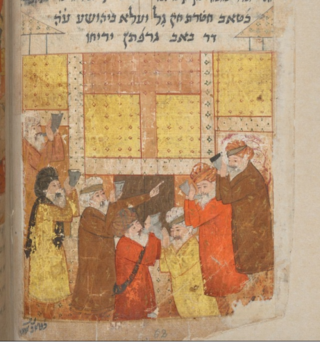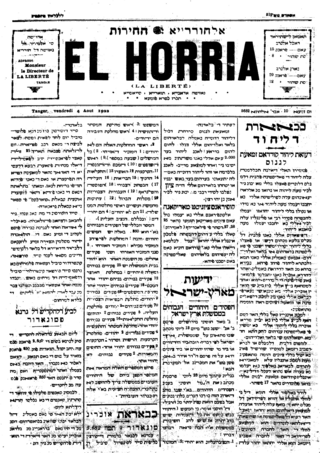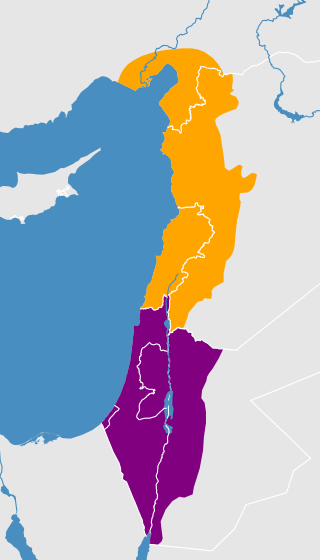Related Research Articles

Judeo-Persian refers to both a group of Jewish dialects spoken by the Jews living in Iran and Judeo-Persian texts. As a collective term, Judeo-Persian refers to a number of Judeo-Iranian languages spoken by Jewish communities throughout the formerly extensive Persian Empire, including the Mountain and Bukharan Jewish communities.

Jewish languages are the various languages and dialects that developed in Jewish communities in the diaspora. The original Jewish language is Hebrew, supplanted as the primary vernacular by Aramaic following the Babylonian exile. Jewish languages feature a syncretism of Hebrew and Judeo-Aramaic with the languages of the local non-Jewish population.

Judeo-Arabic dialects are ethnolects formerly spoken by Jews throughout the Arab world. Under the ISO 639 international standard for language codes, Judeo-Arabic is classified as a macrolanguage under the code jrb, encompassing four languages: Judeo-Moroccan Arabic (aju), Judeo-Yemeni Arabic (jye), Judeo-Egyptian Arabic (yhd), and Judeo-Tripolitanian Arabic (yud).

Mizrahi Jews, also known as Mizrahim (מִזְרָחִים) or Mizrachi (מִזְרָחִי) and alternatively referred to as Oriental Jews or Edot HaMizrach, are a grouping of Jewish communities that lived in the Muslim world.

Judeo-Berber or Judeo-Amazigh is any of several hybrid Berber varieties traditionally spoken as a second language in Berber Jewish communities of central and southern Morocco, and perhaps earlier in Algeria. Judeo-Berber is a contact language; the first language of speakers was Judeo-Arabic. Speakers immigrated to Israel in the 1950s and 1960s. While mutually comprehensible with the Tamazight spoken by most inhabitants of the area, these varieties are distinguished by the use of Hebrew loanwords and the pronunciation of š as s.
Judeo-Italian is an endangered Jewish language, with only about 200 speakers in Italy and 250 total speakers today. The language is one of the Italian languages and one of the Jewish Romance Languages. Some words have Italian prefixes and suffixes added to Hebrew words as well as Aramaic, roots. All of the language's dialects except one are now extinct.
Yevanic, also known as Judaeo-Greek, Romaniyot, Romaniote, and Yevanitika, is a Greek dialect formerly used by the Romaniotes and by the Constantinopolitan Karaites. The Romaniotes are a group of Greek Jews whose presence in the Levant is documented since the Byzantine period. Its linguistic lineage stems from the Jewish Koine spoken primarily by Hellenistic Jews throughout the region, and includes Hebrew and Aramaic elements. It was mutually intelligible with the Greek dialects of the Christian population. The Romaniotes used the Hebrew alphabet to write Greek and Yevanic texts. Judaeo-Greek has had in its history different spoken variants depending on different eras, geographical and sociocultural backgrounds. The oldest Modern Greek text was found in the Cairo Geniza and is actually a Jewish translation of the Book of Ecclesiastes (Kohelet).
Arab Jews is a term for Jews living in or originating from the Arab world. The term is politically contested, often by Zionists or by Jews with roots in the Arab world who prefer to be identified as Mizrahi Jews. Many left or were expelled from Arab countries in the decades following the founding of Israel in 1948, and took up residence in Israel, Western Europe, the United States and Latin America.

Judeo-Tat or Juhuri is a Judeo-Persian dialect of the Tat language historically spoken by the Mountain Jews, primarily in Azerbaijan, Dagestan, and today in Israel. It belongs to the southwestern group of the Iranian division of the Indo-European languages with heavy influence from the Hebrew language. In the era of Soviet historiography, the Mountain Jews were mistakenly considered to be related to the Muslim Tats of Azerbaijan. However, they do not share a common linguistic heritage, as the Mountain Jews kept their native language, while the Muslim Tats eventually adopted Persian. The words Juvuri and Juvuro translate as "Jewish" and "Jews".

Judeo-Malayalam is the traditional language of the Cochin Jews, from Kerala, in southern India, spoken today by a few dozens of people in Israel and by probably fewer than 25 in India.
Judeo-Hamadani and Judeo-Borujerdi constitute a Northwestern Iranian language, originally spoken by the Iranian Jews of Hamadan and Borujerd in western Iran. Hamadanis refer to their language as ebri "Hebrew" or zabān-e qadim "old language". Though not Hebrew, the term ebri is used to distinguish Judeo-Hamadani from Persian.
In 1920, Hamadan had around 13,000 Jewish residents. According to members of the community that Donald Stilo encountered in 2001-02, there were only eight people from the Jewish community left in Hamadān at the time, but others can still be found in Israel, New York City, and most predominantly in Los Angeles.
Judaeo-Romance languages are Jewish languages derived from Romance languages, spoken by various Jewish communities originating in regions where Romance languages predominate, and altered to such an extent to gain recognition as languages in their own right. The status of many Judaeo-Romance languages is controversial as, despite manuscripts preserving transcriptions of Romance languages using the Hebrew alphabet, there is often little-to-no evidence that these "dialects" were actually spoken by Jews living in the various European nations.
Baghdad Jewish Arabic or autonymhaki mal yihud or el-haki malna is the variety of Arabic spoken by the Jews of Baghdad and other towns of Lower Mesopotamia in Iraq. This dialect differs from the North Mesopotamian Arabic spoken by Jews in Upper Mesopotamian cities such as Mosul and Anah. Baghdadi and Northern Mesopotamian are subvarieties of Judeo-Iraqi Arabic.

Judeo-Moroccan Arabic is the variety or the varieties of the Moroccan vernacular Arabic spoken by Jews living or formerly living in Morocco. Historically, the majority of Moroccan Jews spoke Moroccan vernacular Arabic, or Darija, as their first language, even in Amazigh areas, which was facilitated by their literacy in Hebrew script. The Darija spoken by Moroccan Jews, which they referred to as al-‘arabiya diyalna as opposed to ‘arabiya diyal l-məslimīn, typically had distinct features, such as š>s and ž>z "lisping," some lexical borrowings from Hebrew, and in some regions Hispanic features from the migration of Sephardi Jews following the Alhambra Decree. The Jewish dialects of Darija spoken in different parts of Morocco had more in common with the local Moroccan Arabic dialects than they did with each other.
Judeo-Yemeni Arabic is a variety of Arabic spoken by Jews living or formerly living in Yemen. The language is quite different from mainstream Yemeni Arabic, and is written in the Hebrew alphabet. The cities of Sana'a, Aden, al-Bayda, and Habban District and the villages in their districts each have their own dialect.
Judeo-Tunisian Arabic, also known as Judeo-Tunisian, is a variety of Tunisian Arabic mainly spoken by Jews living or formerly living in Tunisia. Speakers are older adults, and the younger generation has only a passive knowledge of the language.

Palestinian Arabic is a dialect continuum of mutually intelligible varieties of Levantine Arabic spoken by most Palestinians in Palestine, Israel and in the Palestinian diaspora.
Judeo-Algerian Arabic also known as Algerian Judeo-Arabic is a Judeo-Arabic dialect based on Algerian Arabic. Today it is nearly extinct with only a few elderly speakers remaining. The language has a large amount of historical literature. It contained influence from several dialects of Arabic as well as from Hebrew and Aramaic.
Modern Palestinian Judeo-Arabic is a variety of Palestinian Arabic spoken by Jews in Israel. As Jews from Morocco established a community in the Galilee and around Jerusalem, their dialect of Maghrebi Judeo-Arabic mixed with Palestinian Arabic. It peaked at 10,000 speakers and thrived alongside Yiddish until the 20th century. But today it is nearly extinct with only 5 speakers remaining in the Galilee. It would begin to decline due to the revival of Hebrew as Hebrew became the dominant language of the Yishuv, or pre-Israel Jewish population of Palestine. Modern Judeo-Palestinian Arabic contains influence from Judeo-Moroccan Arabic, Judeo-Lebanese Arabic, and Judeo-Syrian Arabic.
References
- ↑ "Recovering Judeo-Arabic". JewishStandard.com.
- 1 2 Arnold, Werner (2013-06-24), "Judeo-Arabic, Syria, Hebrew Component in", Encyclopedia of Hebrew Language and Linguistics, Brill, retrieved 2024-01-25
- 1 2 3 4 "Judeo-Arabic". Jewish Languages. Retrieved 2024-01-25.
- ↑ Blanco, Morris (May 12, 2008). "Echoes of Aleppo Syrian Jewish Music in New York A Synthesis of Religion and Culture" (PDF). Pizmonim: 3 – via Wayback Machine.